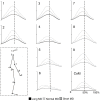Alterations with movement duration in the kinematics of a whole body pointing movement
- PMID: 23341899
- PMCID: PMC3544901
- DOI: 10.1371/journal.pone.0052477
Alterations with movement duration in the kinematics of a whole body pointing movement
Abstract
Our aim was to investigate how the organization of a whole body movement is altered when movement duration (MD) is varied. Subjects performed the same whole body pointing movement over long, normal and short MDs. The kinematic trajectories were then analyzed on a normalized time base. A principal components analysis (PCA) revealed that the degree of coordination between the elevation angles of the body did not change with MD. This lack of significant differences in the coordination was interesting given that small spatial and temporal differences were observed in the individual kinematic trajectories. They were revealed by studying the trajectories of the elevation angles, joint markers and center of mass. The elevation angle excursions displayed modifications primarily in their spatial characteristics. These alterations were more marked for the short rather than long duration movements. The temporal characteristics of the elevation angles as measured by the time to peak of angular velocity were not modified in the same fashion hence displaying a dissociation in the tuning of the spatial and temporal aspects of the elevation angles. Modifications in the temporal characteristics of the movement were also studied by examining the velocity profiles of the joint markers. Interestingly, unlike the disordered nature of this variable for the elevation angles, the time to peak velocity was neatly ordered as a function of MD for the joint markers - It arrived first for the short duration movements, followed by those of the normal and finally long duration movements. Despite the modifications observed in the kinematic trajectories, a PCA with the elevation angle excursions at different MDs revealed that two principal components were sufficient to account for nearly all the variance in the data. Our results suggest that although similar, the kinematic trajectories at different MDs are not achieved by a simple time scaling.
Conflict of interest statement
Figures









Similar articles
-
Modifying upper-limb inter-joint coordination in healthy subjects by training with a robotic exoskeleton.J Neuroeng Rehabil. 2017 Jun 12;14(1):55. doi: 10.1186/s12984-017-0254-x. J Neuroeng Rehabil. 2017. PMID: 28606179 Free PMC article.
-
Coordination of multi-joint arm movements in cerebellar ataxia: analysis of hand and angular kinematics.Exp Brain Res. 1998 Apr;119(4):483-92. doi: 10.1007/s002210050364. Exp Brain Res. 1998. PMID: 9588783 Clinical Trial.
-
Axial synergies during human upper trunk bending.Exp Brain Res. 1998 Jan;118(2):210-20. doi: 10.1007/s002210050274. Exp Brain Res. 1998. PMID: 9547090 Clinical Trial.
-
Kinematic and dynamic synergies of human precision-grip movements.J Neurophysiol. 2005 Oct;94(4):2284-94. doi: 10.1152/jn.01310.2004. Epub 2005 May 25. J Neurophysiol. 2005. PMID: 15917316
-
Strategy of arm movement control is determined by minimization of neural effort for joint coordination.Exp Brain Res. 2016 Jun;234(6):1335-50. doi: 10.1007/s00221-016-4610-z. Epub 2016 Mar 16. Exp Brain Res. 2016. PMID: 26983620 Review.
References
-
- Hollerbach JM, Flash T (1982) Dynamic interaction between limb segments during planar arm movements. Biol Cybern 44: 67–77. - PubMed
-
- Gottlieb GL, Corcos DM, Agarwal G (1989) Strategies for the control of voluntary movements with one mechanical degree of freedom. Behavioral and Brain Sciences 12: 189–250.
-
- Gottlieb GL, Song Q, Hong DA, Almeida GL, Corcos D (1996) Coordinating movement at two joints: a principal of linear covariance. J Neurophysiol 75: 1760–1764. - PubMed
Publication types
MeSH terms
LinkOut - more resources
Full Text Sources
Other Literature Sources
Research Materials
Miscellaneous

